
Zool: Ninja of the Nth Dimension is a platform game written for the Amiga by Gremlin Graphics and published in 1992. It was marketed as a rival to Sega's Sonic the Hedgehog. Zool was ported to other platforms and followed by Zool 2 in 1993.

Blockout is a puzzle video game published in 1989 by California Dreams. It was developed in Poland by Aleksander Ustaszewski and Mirosław Zabłocki. American Technos published an arcade version. Blockout is an unlicensed, 3D version of Tetris.

Lethal Xcess, also known as Lethal Xcess: Wings of Death II or just Wings of Death II, is a shoot 'em up game developed by two members of demo crew X-Troll and published by Eclipse Software in 1991 for the Atari ST and Amiga. It is a sequel to 1990's Wings of Death, in which its wizard hero goes into the far future to fight the descendants of the evil witch that he had defeated in the first game. Despite having been acclaimed by critics, the game was a commercial failure.
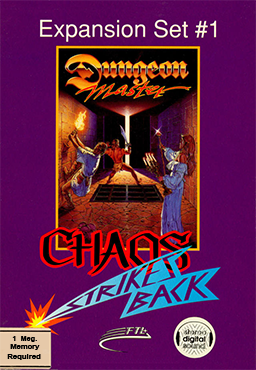
Chaos Strikes Back is an expansion and sequel to Dungeon Master, the earlier 3D role-playing video game. Chaos Strikes Back was released in 1989 and is also available on several platforms. It uses the same engine as Dungeon Master, with new graphics and a new, far more challenging, dungeon.
Geoff Crammond is a computer game designer and programmer who specialises in motor racing games. A former defence industry systems engineer, he claims to have had little interest in motor racing before programming his first racing game (Revs) back in 1984, but he holds a physics degree, which may explain the realism of some of his programming. As a consequence of that project he became a big fan of Formula One motor racing. At the end of the 80s, this interest, plus the ever improving capabilities of home computers, inspired him to specialise in programming Formula One racing simulations.

F-19 Stealth Fighter is a combat flight simulator developed and released in 1988 and 1990 by MicroProse, featuring a fictional United States military aircraft. It is the 16-bit remake of the 8-bit game Project Stealth Fighter, which was released for the Commodore 64 in 1987. It was also ported to the NEC PC-9801 in Japan only, and the DOS version was re-released on Steam distribution platform in 2015.

Turrican is a 1990 video game developed by Manfred Trenz. It was developed for the Commodore 64 by Rainbow Arts, and was ported to other systems later. In addition to concept design and character creation, Trenz programmed Turrican on the Commodore 64. A sequel, Turrican II: The Final Fight, followed in 1991 for the Commodore 64 and other platforms.
Artworx was a Naples, Florida software company that produced and supported a line of computer games from 1981 to 2020. It is named after the founder's given name. At first the company published a variety of games, including titles in adventure and arcade-action genres, but were later best known for a strip poker series.

S.D.I. is a 1986 Action-adventure game developed and published by Cinemaware. The game is set during the Cold War.
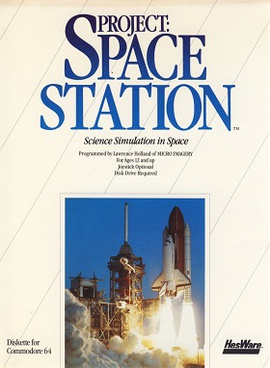
Project Space Station is a simulation game written for the Commodore 64 computer published in 1985 by HESware. It was ported to the Apple II and DOS in 1987.

Epic is a space combat simulation game developed by Digital Image Design and published by Ocean Software for the Commdore Amiga and Atari ST in early 1992. A port to MS-DOS also appeared in the same year, followed by a version for the NEC PC-9801 in 1993. A sequel, titled Inferno, was released in 1994 for PCs only.

Double Dragon is a 1987 beat 'em up video game developed by Technōs Japan and distributed by Taito for arcades across Asia, North America and Europe. It is the first title in the Double Dragon franchise. The game's development was led by Yoshihisa Kishimoto, and it is a spiritual and technological successor to Technos' earlier beat 'em up, Nekketsu Kōha Kunio-kun (1986), released outside of Japan by Taito as Renegade; Kishimoto originally envisioned it as a direct sequel and part of the Kunio-kun series, before making it a new game with a different cast and setting.
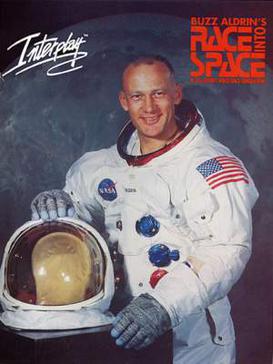
Buzz Aldrin's Race Into Space, frequently abbreviated BARIS, is a 1993 space simulation strategy game for MS-DOS. The player takes the role of Administrator of NASA or head of the Soviet space program with the ultimate goal of being the first side to conduct a successful crewed Moon landing. It was developed by Strategic Visions and published by Interplay Productions as a computer version of Liftoff!, a 1989 board game developed by Fritz Bronner. BARIS was re-released in 1994 on CD-ROM, incorporating the earlier updates to the floppy disk version, a few new updates, improved video of the mission launches, and new multiplayer modes.

Forgotten Worlds, titled Lost Worlds in Japan, is a side-scrolling shooter video game by Capcom, originally released as a coin-operated arcade game in 1988. It is notable for being the first title released by Capcom for their CP System arcade game hardware.

Shuttle is a space flight simulator game developed by Vektor Grafix and published by Virgin Games. It was released in 1992 on the IBM PC, Amiga and Atari ST.
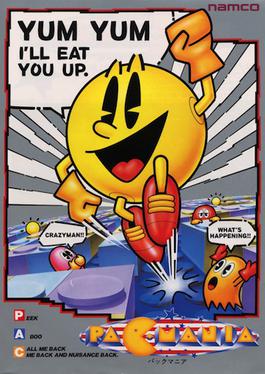
Pac-Mania is a cavalier perspective maze game that was developed and released by Namco for arcades in 1987. In the game, the player controls Pac-Man as he must eat all of the dots while avoiding the colored ghosts that chase him in the maze. Eating large flashing "Power Pellets" will allow Pac-Man to eat the ghosts for bonus points, which lasts for a short period of time. A new feature to this game allows Pac-Man to jump over the ghosts to evade capture. It is the ninth title in the Pac-Man video game series and was the last one developed for arcades up until the release of Pac-Man Arrangement in 1996. Development was directed by Pac-Man creator Toru Iwatani. It was licensed to Atari Games for release in North America.
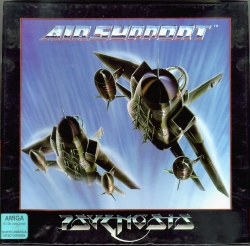
Air Support is a 1992 game for the Amiga and Atari ST. It is a top-down strategy game, with a first-person mode available for special missions. The game takes place during a retro-futuristic 21st century where all wars are fought in virtual reality.
A space flight simulation is a genre of flight simulator video games that lets players experience space flight to varying degrees of realism. Common mechanics include space exploration, space trade and space combat.

Falcon is a combat flight simulator video game and the first official entry in the Falcon series of the F-16 jet fighter's simulators by Spectrum HoloByte. Originally developed by Sphere for Macintosh and MS-DOS in 1987 and ported to several platforms between 1988 and 1992, the game earned commercial success and critical acclaim.

Vroom is a 1991 racing video game developed and published by Lankhor and programmed by Daniel Macré. The game was first released in 1991 for the Atari ST and later for the Amiga and MS-DOS.

















